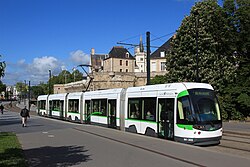| Nantes tramway | |||
|---|---|---|---|
 | |||
| Overview | |||
| Native name | Tramway de Nantes | ||
| Locale | Nantes, Pays de la Loire, France | ||
| Transit type | Tram | ||
| Number of lines | 3 | ||
| Number of stations | 83 | ||
| Annual ridership | 73.89 million (2018)[1] | ||
| Operation | |||
| Began operation | 7 January 1985[1] | ||
| Operator(s) | Semitan | ||
| Technical | |||
| System length | 44.3 km (27.5 mi) | ||
| Track gauge | 1,435 mm (4 ft 8+1⁄2 in) | ||
| |||
The Nantes tramway (French: Tramway de Nantes) is a tramway system operating in the city of Nantes in Pays de la Loire, France. The first tramway in Nantes opened in 1879 and closed in 1958 due to bombing damage during World War II, while the present tramway was re-introduced to the city in 1985.
The first tramway in Nantes was notable for its use of compressed air propulsion pioneering this technology. In the 1980s, Nantes became the first city in Europe to re-introduce the present tramway which was the first modern 'new generation' tramway to be built, reversing the trend of tramway closures that had been going on since the middle of the 20th century and becoming the first in a wave of tramways built from scratch in France and the rest of Europe.
The current Nantes tramway network consists of three lines, is 43-kilometre (27 mi) long and serves 83 stations. It is operated by Semitan (commercially known as TAN), the operator of Nantes public transport network. All new MRT lines are busway lines (two BRT lines) and have gained much more riders than planned.
- ^ a b "Rapport annuel 2018 sur le parc, le trafic et les événements d'exploitation des tramways" (PDF) (in French). STRMTG - Service Technique des Remontées Mécaniques et des Transports Guidés. 20 December 2019. p. 11. Retrieved 2 September 2020.
